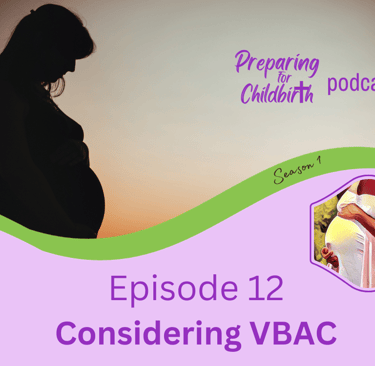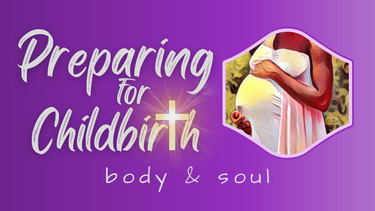12-Considering VBAC
In today’s show we talk about the benefits and risks involved in planning a repeat c-section and why trying for a Vaginal Birth After Cesarean may be a good alternative.
5/3/20237 min read


Transcript:
Episode 12 –.
Welcome to the Preparing for Childbirth podcast where we'll talk about God's amazing design for childbirth, learn how to prepare for the unknown, handle the pain and lean into God's character through it all! I'm your host, Jenny Childs. I’m a follower of Jesus, wife, mom, and lover of all things childbirth. Thanks so much for joining me today!
This is episode 12.
Last time we talked a lot about cesarean sections so I want to follow that up today, as promised, with a conversation about childbirth options for future pregnancies after a cesarean. In short, there are three possible birth outcomes after a prior cesarean. 1- a scheduled repeat cesarean at term without going through labor. 2- Labor and a VBAC, that’s a Vaginal Birth after a Cesarean. Or 3- Labor that results in another cesarean. Today we’re going to talk about the benefits and risks involved in planning a repeat c-section and why trying for a Vaginal Birth After Cesarean may be a good alternative.
I will go ahead and say up front that research supports VBAC as a safe, lower-risk birth option than routine repeat c-sections. That does not mean that it is the right decision for every woman in every situation. This is where you will need to use your BRAIN to make the right choice for you and your baby. If you’ve listened to the podcast before, you know what I mean by use your BRAIN. The acronym stands for Benefits, Risks, Alternatives, Intuition, and Now or Never. You can check out the link in the show notes for a more thorough explanation.
So, let’s start with B - the benefits of a repeat Cesarean. One is that the risk of complication from cesarean surgery is lower with a planned cesarean than if you labor for a VBAC and then end up needing another c-section. Another benefit is that you avoid any further stretching of the pelvic floor and avoid the possibility of vaginal tears. You are also less likely to experience pelvic floor muscle weakness. It does not, however, eliminate the possibility of pelvic floor issues. Another benefit that people often think about - technically, the uterine scar from your previous cesarean is less likely to separate if you have an elective repeat cesarean. However, the risk of uterine rupture is still pretty small even with a VBAC. There may be other benefits depending on your individual situation.
Now for R - some of the risks involved with a repeat cesarean. Research shows that c-sections may do more harm than good for healthy pregnant mamas and their babies. Every cesarean leads to an increased risk of placenta problems in future pregnancies, such as the placenta growing over the cervix or imbedding too deeply in the uterine wall. Multiple cesarean surgeries also raise the risk for operative complications. And each additional cesarean increases the chances for uterine rupture, blood transfusion, blood clots, cardiac arrest, and hemorrhage that could require a hysterectomy, among other risks.
There is also a somewhat higher rate of postpartum anxiety or depression following a c-section. To help prevent that you can be involved in the decision-making process, knowing why a c-section is the best option if that’s the case for you and choose to trust God with the outcome no matter what happens. Sometimes, tho’, even when you do all the right things, you may find yourself struggling with anxiety or even postpartum depression in the days, weeks or months following birth (whether you had a cs or not). If this happens with you, don’t wait to reach out to someone. There is help available.
If mama &/or baby is not healthy for some reason, the benefits of a repeat cesarean may outweigh the risks. This is why it’s so important to do your research, ask good questions and, along with your care provider, make an informed decision that is unique to your situation.
So, thinking about our BRAIN acronym, we’ve talked about the B-Benefits, R-Risks. Now for A -Alternatives… VBAC is a safe alternative to a routine repeat cesarean for most mamas. This includes mamas expecting to give birth to a big baby, mamas whose pregnancy extends past 40 weeks, mamas who are overweight, mamas expecting twins, & others. It’s not fool-proof. There is no guarantee if you try for a VBAC that you won’t end up with another cesarean. And there are some contraindications, meaning there are some reasons that would make planning for a VBAC unsafe. Those include a prior uterine rupture, a prior uterine surgery (such as a myomectomy, that’s a surgery to remove fibroids), a classical scar (meaning one that is from a high vertical uterine incision) or an inverted T scar in the upper part of the uterus). There is evidence to show that moms with an unknown type of prior uterine scar can still plan for a VBAC.
If your pregnancy is healthy, you have a low horizontal scar on your uterus from your previous cesarean and labor starts spontaneously at term (that is, before 41 weeks gestation), there is about a 70-75 percent chance of having a safe normal birth. That means that about 70 - 75 out of 100 women who labor for a VBAC avoid the complications of repeat cesareans. The chances go up for achieving a safe normal birth for women who are supported by a birth doula and they are even better for women who are cared for by midwives or who labor in a birth center. Those stats are actually not that far off from what a normal first-time mama would face.
Let me just add in here that even if you’ve had multiple cesareans, it may still be possible for you to safely labor for a VBAC. Do your research and talk to your doctor. I will also say that once you’ve hit 41 weeks, evidence shows that induction of labor is a valid option, even with a VBAC. Here again is a place to use that BRAIN acronym to make an informed decision for your specific situation.
The recovery time following a vaginal birth is much shorter and easier than recovery after a cesarean. It also makes it easier to bond with your baby and initiate breastfeeding. Those things are by no means impossible after a cesarean or a repeat cesarean, it will just likely take more intentionality and effort. A vaginal birth is also beneficial for baby in that passing through the birth canal helps to squeeze fluid from baby’s lungs preparing him for his first breaths. Babies born via CS are more likely to have breathing problems compared to babies born vaginally. Again, if a Cesarean is needed, doctors and hospital staff are well equipped to deal with those initial breathing problems, which are usually mild and babies recover quickly. It might mean some separation from baby as he is being cared for.
Some stats will compare mother and infant mortality rates for repeat cesareans and VBACs. I’m not going to do that here. There are numbers than can be compared but the truth is that while death is a possibility in either case, it’s rare. Any time you give birth (or do anything for that matter), there is a possibility of complications. I would encourage you not to let fear drive your decision, rather look to God for guidance as you weigh benefits and risks and consider alternatives. Talk together with your spouse or another trusted support person. Pray for wisdom and hopefully with the help and cooperation of your doctor, make the best decision you can for your unique situation.
In my research I came across a great free resource with so much easy to understand evidence-based information. It’s called the VBAC Education Project, and you can find it at VBAC.com. I’ll also put a link in my show notes. Much of what I shared today was gleaned from this resource and I’ve barely scratched the surface of what they have to offer. I encourage you to check it out if you’re considering a VBAC.
I’ll be back again in two weeks for one more podcast to finish out season 1 of the Preparing for Childbirth Podcast. Then, I’ll be taking a break from podcasting in June and July to focus on making some videos for my online course. I’m hoping to make that available by the end of the summer. In the meantime, I’m still available for one-on-one live video coaching. You can check out my link in the show notes for more information about that. Or reach out about in-person options if you’re in the Manchester TN area. You can also go to my website link and subscribe to my email list if you want to keep up with how things are going with the video making over the summer. I’ll be sharing some sneak peaks along the way, as well.
If you’ve enjoyed today’s podcast or found it helpful, I hope you’ll share it with a friend, and I’d love for you to leave a rating and review.
It is my prayer that these podcasts will help you grow in confidence and peace as the day draws near for you to meet your little one. I'm so glad you tuned in today as you are Preparing for Childbirth.
Show notes:
In today’s show we talk about the benefits and risks involved in planning a repeat c-section and why trying for a Vaginal Birth After Cesarean may be a good alternative.
Links mentioned in this episode:
Scroll to the bottom of the page to access the free learning modules.
Connect with me:
Instagram Facebook Website Video Coaching
Resources used to prepare this episode:
Kamel, J. (2021, May 6). Myth: VBACs should never be induced - VBAC Facts®. VBAC Facts®. https://vbacfacts.com/2012/05/27/myth-vbacs-should-never-be-induced/
Lamaze International. (2019, September 23). A Woman’s Guide to VBAC. Lamaze International. https://www.lamaze.org/Giving-Birth-with-Confidence/GBWC-Post/TitleLink/A-Womans-Guide-to-VBAC
Lcce, C. T. (2018, December 19). Birth Planning and VBAC. Lamaze International. https://www.lamaze.org/Giving-Birth-with-Confidence/GBWC-Post/TitleLink/Birth-Planning-and-VBAC
VBAC. (2023, April 9). Home. https://vbac.com/
© Preparing for Childbirth 2025.
All rights reserved.
Disclaimer: Content and information on this website and related social media are for informational and educational purposes only and are not intended to be a substitute for professional medical advice, diagnosis, or treatment. Users are advised to consult their physician or midwife when making decisions about care.
